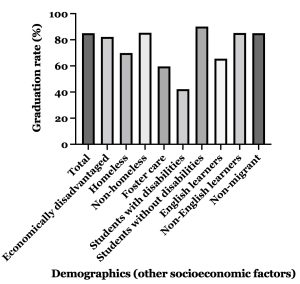by Chunwen Ko

(Fieldstadt, 2020)
Demographics

This pie chart illustrates the demographic makeup of Mississippi’s public school student population (Data Explorer).


These figures illustrate the overall graduation rate of Mississippi’s public schools, as well as the graduation rates of different demographics (NERD$ FY20).
Spending
Mississippi has 442,122 students in its public school system (2020–2021 Superintendent’s Annual Report). The state has a public education budget of $4.91 billion, but it spent $6.39 billion this year (U.S. Public Education Spending Statistics, 2022).
There are conflicting data regarding Mississippi’s per-pupil expenditure: according to the state’s Department of Education, the state spent $10,655 per student in the 2019–2020 school year (2019–2020 Superintendent’s Annual Report), but according to Georgetown University’s Edunomics Lab, the state spent $9189.61 per student that year (NERD$ FY20). According to the state Department of Education, this figure increased to $12,107 in the 2020–2021 school year (2020–2021 Superintendent’s Annual Report). There are also significant funding discrepancies within the state when it comes to per-pupil spending. Moss Point School District spent $15,263.18 per student in the 2019–2020 school year, while Neshoba County School District spent $7,353.32 per student that year (NERD$ FY20). In comparison, the national average per-pupil expenditure is $14,455 (U.S. Public Education Spending Statistics, 2022).
Testing and accountability
Mississippi does have statewide assessments for math and English. In the 2020–2021 school year, 36.0% of students demonstrated proficiency in math, while 35.0% of students demonstrated proficiency in English (Accountability Data).
Common Core was adopted on August 20, 2010 (The Common Core State Standards: Mississippi’s Adoption and Implementation), and later, legislators renamed these standards the Mississippi College and Career Readiness Standards (Skinner, 2015). A bill has been introduced to remove Common Core standards from the curriculum, but it has not passed (Hill, 2021). In addition, Next Generation Science Standards have also been implemented (Science).
Charter/Private Schools and Vouchers
There are only eight charter schools in Mississippi (Authorized Charter Schools). In contrast, private schools serve a much larger demographic: in 2013, Mississippi had 50,330 students in private schools (with that number declining between 2003 and 2013) (School Choice in Mississippi). This was about 9.34% of Mississippi’s school-age population at the time (School Choice in Mississippi).
There are two voucher programs in Mississippi, one for students who require speech-language therapy (Speech-Language Therapy Scholarship (Nate Rogers)) and one for students who require dyslexia therapy (Dyslexia). In 2019, the funding for these programs increased from $3 million to $5 million (Harrison & Skinner, 2019).
Teachers
Mississippi’s average teacher salary is $46,862 (2020–2021 Superintendent’s Annual Report), which is the lowest average teacher salary of all fifty states (Wheelwright, 2021). Mississippi has a School Recognition Program that provides a bonus to school staff at schools that were deemed high-performing enough or to have improved enough (School Recognition Program). However, due to funding changes resulting from the COVID-19 pandemic, the School Recognition Program was not funded this school year (Royals, 2021).
Mississippi has two major groups representing teachers: the Mississippi Association of Educators (MAE), which is part of the National Education Association (NEA) network (Home), as well as the American Federation of Teachers (AFT) (American Federation of Teachers / MS). However, Mississippi is a right-to-work state, meaning that union membership is not required for educators. Unions in Mississippi are also not allowed to mass picket or demonstrate (Dreher, 2018).
Mississippi, like other states, require aspiring educators to take the Praxis exam (Harris, 2017). Mississippi teachers are also subject to two informal observations and one formal observation every year. They are evaluated using the Teacher Growth Rubric developed by the state’s Department of Education (Teacher).
Current trend: teacher shortage
Mississippi is facing a massive teacher shortage. The state currently has 3,036 teaching vacancies across the state (5,503 vacancies if you include support/administrative staff) (James, 2021). And on top of this, a survey conducted in February of this year found that over half of all teachers in Mississippi are considering quitting within a year (Ballard, 2022). These are all indicators of deep dissatisfaction with teaching in Mississippi.
The survey found that low pay was a big reason why Mississippi teachers are dissatisfied with their jobs. More than a third of teachers in the state have to work additional jobs to make ends meet, and nearly half are unable to afford childcare or healthcare outside of insurance coverage. A quarter of all teachers in Mississippi are either food insecure, housing insecure, or transportation insecure—or a combination of the above. When presented with a list of solutions, 88% of teachers chose a $3,000 raise as the most impactful (Ballard, 2022).
As mentioned earlier, Mississippi has the lowest average teacher salary in the nation (Wheelwright, 2021). Clearly, that has a very negative impact on teacher satisfaction and retention. The fact that teachers are unable to protest for better wages (Dreher, 2018) makes it even more difficult for salaries to increase. If Mississippi’s Department of Education does not act quickly, the problem will only persist, if not worsen.
So what does this all mean?
Mississippi faces many challenges in education. One major challenge is the inequities in its education system. The school district spending the most per pupil spends more than twice the amount of money spent by the school district spending the least per pupil (NERD$ FY20). And there are major discrepancies in educational outcomes as well—for example, students with no disabilities are more than twice as likely to graduate high school than students with disabilities. Graduation rates are also low for students who are homeless or in foster care (NERD$ FY20). Clearly, the education system must consider these factors that affect students’ educational experiences and allocate more resources toward students with difficult lives outside of school.
And as I have discussed previously, Mississippi is a state with very low teacher pay (Wheelwright, 2021), and does not allow teachers to effectively organize for better wages (Dreher, 2018). Both educational inequities and low teacher satisfaction point to one overarching problem—the lack of funding. If Mississippi had access to more funding, it would be able to even out its funding discrepancies, as well as direct resources toward students who may need them more. Funding would also increase teacher pay, which, according to the aforementioned survey, is seen as the most impactful solution to Mississippi’s teacher retention problem (Ballard, 2022). All of these, of course, are contingent on responsible financial planning and management—but all of these initiatives would be made possible if Mississippi received more funding. Mississippi does appear to be spending more on its students in recent years (2019–2020 Superintendent’s Annual Report, 2020–2021 Superintendent’s Annual Report), so it is exciting to await the results of increased spending, though also worrying as there is little evidence of increased funding, especially as Mississippi’s education system is operating on a budget deficit (U.S. Public Education Spending Statistics, 2022). But as Mississippi’s students and teachers continue to suffer under an unjust system, one thing is clear: there is no room to go backward.
References
Click here to access the list of references.